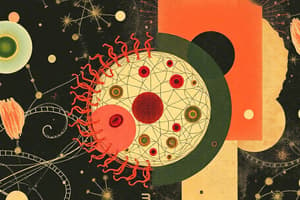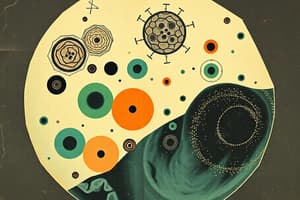Podcast
Questions and Answers
What is the primary function of the nucleolus?
What is the primary function of the nucleolus?
- Protein degradation
- Lipid synthesis
- DNA replication
- Ribosome synthesis (correct)
What is the composition of the nucleolus?
What is the composition of the nucleolus?
- Proteins and RNA (correct)
- Carbohydrates and DNA
- DNA and lipids
- Lipids and carbohydrates
Which of the following cellular components is directly assembled within the nucleolus?
Which of the following cellular components is directly assembled within the nucleolus?
- Endoplasmic reticulum
- Mitochondria
- Lysosomes
- Ribosomes (correct)
If a cell's nucleolus is not functioning correctly, which process would be most immediately affected?
If a cell's nucleolus is not functioning correctly, which process would be most immediately affected?
A researcher observes a cell with an unusually large nucleolus. What might this indicate about the cell's activity?
A researcher observes a cell with an unusually large nucleolus. What might this indicate about the cell's activity?
Flashcards
Nucleus
Nucleus
A cell structure containing the cell's genetic material in the form of DNA.
Chromosome
Chromosome
Thread-like structures made of DNA and proteins, carrying genetic information.
Nucleolus
Nucleolus
A structure within the nucleus responsible for ribosome synthesis.
Ribosomes
Ribosomes
Signup and view all the flashcards
Ribosome Synthesis
Ribosome Synthesis
Signup and view all the flashcards
Study Notes
- Nucleus and Chromosome structures
Nucleus
- The nucleus is a membrane-bound structure containing hereditary information and controls cell growth/reproduction.
- The nucleus is the most prominent organelle, surrounded by a nuclear envelope.
Nuclear Components
- Nucleolus
- Nuclear pore
- Nuclear envelope
- Nucleoplasm
- Chromatin
Nucleus Details
- The nucleus is the largest cellular organelle in animal cells
- The average nuclear diameter is 6 micrometers, occupying about 10% of the cell volume
- The viscous liquid within is called nucleoplasm, similar to cytosol.
- The nucleus appears as a dense, roughly spherical, or irregular organelle.
- The composition by dry weight: DNA 9%, RNA 1%, Histone Proteins 11%, Acidic Proteins 65%.
- The nuclear envelope consists of two nuclear membranes and an underlying nuclear lamina.
- The nucleus is surrounded by inner and outer nuclear membranes
- The outer nuclear membrane is continuous with the endoplasmic reticulum.
- Each nuclear membrane is a phospholipid bilayer permeable only to small molecules.
- Outer nuclear membranes join at nuclear pore complexes where molecules pass through.
- Underlying the inner nuclear membrane is the nuclear lamina, a fibrous network for structural support.
- Nuclear lamina consists of 60-80 kilodalton fibrous proteins called lamins.
- Nuclear lamina offer mechanical support and regulate cell events like DNA replication and cell division and participates in Chromatin organization.
Progeria
- Progeria was first described in 1886 by Jonathan Hutchinson and Hastings Gilford.
- The LMNA gene codes for lamin A.
- Progeria's cause is a point mutation in the LMNA gene, where cytosine is replaced with thymine.
Chromosome Position
- Chromosomes are located inside the nucleus.
- Chromosomes consist of coiled DNA molecules.
Chromosome History
- Chromosomes are rod-shaped, dark-stained bodies seen during metaphase of mitosis.
- Strausberger discovered chromosomes in 1875.
- The term chromosome was coined by Waldeyer in 1888.
- Term initiated as (Chroma= Colour and Soma = body)
Eukaryotic Chromosome Features
- Chromosomes are best visible during metaphase.
- Chromosomes bear genes in a linear fashion.
- The shape, size, and number of chromosomes vary in different species.
- Chromosomes can self-duplicate and mutate.
- Chromosomes are composed of DNA, RNA, and protein.
Chromosome Size
- Chromosome size is measured at mitotic metaphase in length and diameter.
- Plants usually have longer chromosomes than animals.
- Plant chromosomes are 0.8-7μm in length, while animal chromosomes are 0.5-4μm in length.
- Chromosome size varies from species to species.
Chromosome Diagram
- Chromatid
- Centromere
- Short arm
- Long arm
Ribosome Hub
- Nucleolus, made of proteins and RNA, is responsible for ribosome synthesis.
Studying That Suits You
Use AI to generate personalized quizzes and flashcards to suit your learning preferences.




